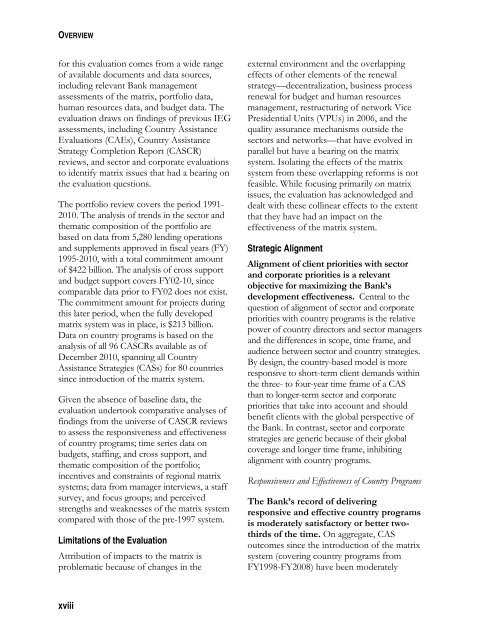The Matrix System at Work - Independent Evaluation Group - World ...
The Matrix System at Work - Independent Evaluation Group - World ...
The Matrix System at Work - Independent Evaluation Group - World ...
You also want an ePaper? Increase the reach of your titles
YUMPU automatically turns print PDFs into web optimized ePapers that Google loves.
OVERVIEW<br />
for this evalu<strong>at</strong>ion comes from a wide range<br />
of available documents and d<strong>at</strong>a sources,<br />
including relevant Bank management<br />
assessments of the m<strong>at</strong>rix, portfolio d<strong>at</strong>a,<br />
human resources d<strong>at</strong>a, and budget d<strong>at</strong>a. <strong>The</strong><br />
evalu<strong>at</strong>ion draws on findings of previous IEG<br />
assessments, including Country Assistance<br />
Evalu<strong>at</strong>ions (CAEs), Country Assistance<br />
Str<strong>at</strong>egy Completion Report (CASCR)<br />
reviews, and sector and corpor<strong>at</strong>e evalu<strong>at</strong>ions<br />
to identify m<strong>at</strong>rix issues th<strong>at</strong> had a bearing on<br />
the evalu<strong>at</strong>ion questions.<br />
<strong>The</strong> portfolio review covers the period 1991-<br />
2010. <strong>The</strong> analysis of trends in the sector and<br />
them<strong>at</strong>ic composition of the portfolio are<br />
based on d<strong>at</strong>a from 5,280 lending oper<strong>at</strong>ions<br />
and supplements approved in fiscal years (FY)<br />
1995-2010, with a total commitment amount<br />
of $422 billion. <strong>The</strong> analysis of cross support<br />
and budget support covers FY02-10, since<br />
comparable d<strong>at</strong>a prior to FY02 does not exist.<br />
<strong>The</strong> commitment amount for projects during<br />
this l<strong>at</strong>er period, when the fully developed<br />
m<strong>at</strong>rix system was in place, is $213 billion.<br />
D<strong>at</strong>a on country programs is based on the<br />
analysis of all 96 CASCRs available as of<br />
December 2010, spanning all Country<br />
Assistance Str<strong>at</strong>egies (CASs) for 80 countries<br />
since introduction of the m<strong>at</strong>rix system.<br />
Given the absence of baseline d<strong>at</strong>a, the<br />
evalu<strong>at</strong>ion undertook compar<strong>at</strong>ive analyses of<br />
findings from the universe of CASCR reviews<br />
to assess the responsiveness and effectiveness<br />
of country programs; time series d<strong>at</strong>a on<br />
budgets, staffing, and cross support, and<br />
them<strong>at</strong>ic composition of the portfolio;<br />
incentives and constraints of regional m<strong>at</strong>rix<br />
systems; d<strong>at</strong>a from manager interviews, a staff<br />
survey, and focus groups; and perceived<br />
strengths and weaknesses of the m<strong>at</strong>rix system<br />
compared with those of the pre-1997 system.<br />
Limit<strong>at</strong>ions of the Evalu<strong>at</strong>ion<br />
Attribution of impacts to the m<strong>at</strong>rix is<br />
problem<strong>at</strong>ic because of changes in the<br />
external environment and the overlapping<br />
effects of other elements of the renewal<br />
str<strong>at</strong>egy—decentraliz<strong>at</strong>ion, business process<br />
renewal for budget and human resources<br />
management, restructuring of network Vice<br />
Presidential Units (VPUs) in 2006, and the<br />
quality assurance mechanisms outside the<br />
sectors and networks—th<strong>at</strong> have evolved in<br />
parallel but have a bearing on the m<strong>at</strong>rix<br />
system. Isol<strong>at</strong>ing the effects of the m<strong>at</strong>rix<br />
system from these overlapping reforms is not<br />
feasible. While focusing primarily on m<strong>at</strong>rix<br />
issues, the evalu<strong>at</strong>ion has acknowledged and<br />
dealt with these collinear effects to the extent<br />
th<strong>at</strong> they have had an impact on the<br />
effectiveness of the m<strong>at</strong>rix system.<br />
Str<strong>at</strong>egic Alignment<br />
Alignment of client priorities with sector<br />
and corpor<strong>at</strong>e priorities is a relevant<br />
objective for maximizing the Bank’s<br />
development effectiveness. Central to the<br />
question of alignment of sector and corpor<strong>at</strong>e<br />
priorities with country programs is the rel<strong>at</strong>ive<br />
power of country directors and sector managers<br />
and the differences in scope, time frame, and<br />
audience between sector and country str<strong>at</strong>egies.<br />
By design, the country-based model is more<br />
responsive to short-term client demands within<br />
the three- to four-year time frame of a CAS<br />
than to longer-term sector and corpor<strong>at</strong>e<br />
priorities th<strong>at</strong> take into account and should<br />
benefit clients with the global perspective of<br />
the Bank. In contrast, sector and corpor<strong>at</strong>e<br />
str<strong>at</strong>egies are generic because of their global<br />
coverage and longer time frame, inhibiting<br />
alignment with country programs.<br />
Responsiveness and Effectiveness of Country Programs<br />
<strong>The</strong> Bank’s record of delivering<br />
responsive and effective country programs<br />
is moder<strong>at</strong>ely s<strong>at</strong>isfactory or better twothirds<br />
of the time. On aggreg<strong>at</strong>e, CAS<br />
outcomes since the introduction of the m<strong>at</strong>rix<br />
system (covering country programs from<br />
FY1998-FY2008) have been moder<strong>at</strong>ely<br />
xviii

















